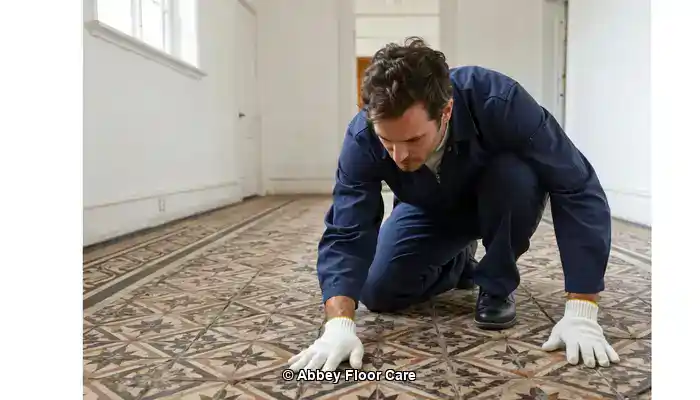
Last Updated on October 30, 2025 by David
Effective Strategies to Revitalise Colour and Pigment in Faded Victorian Mosaic Tiles
- Victorian mosaic tiles frequently lose their colour due to ingrained dirt, outdated coatings, and surface wear, not merely from age. This deterioration can be remedied through a series of strategic restoration techniques.
- Harsh chemicals and aggressive scrubbing can strip original pigments, particularly on encaustic and geometric tiles, leading to irreversible damage. Using gentle methods preserves their unique characteristics.
- Safe restoration begins with deep cleaning using pH-neutral solutions and low-speed rotary machines equipped with soft brushes, ensuring that the tiles are treated delicately during the cleaning process.
- Old sealers and waxes must be carefully removed to expose the true condition of the tile surface, allowing for a more accurate assessment and treatment of the tiles.
- Colour enhancement is possible with breathable, stone-safe sealers that deepen hues without creating a glossy surface, enhancing the natural beauty of the tiles.
- Professional restoration can revive original pigments without the need for repainting or artificial colours, preserving authenticity and ensuring that the tiles maintain their historical significance.
- Maintaining restored tiles requires gentle cleaning regimens and avoiding acidic or bleach-based products to ensure their longevity and aesthetic appeal.
- Heritage-sensitive methods safeguard both aesthetic and historical value, ensuring that the tiles are not only beautiful but also respectful of their origins.
Exploring Effective Techniques for Restoring Victorian Tiles

Abbey Floor Care restoring the colour to a Victorian clay tile floor using a colour-enhancing impregnating sealer.
Victorian encaustic and mosaic tiles represent a vital aspect of British architectural heritage, celebrated for their intricate craftsmanship and unique colour palettes composed of mineral pigments fused directly into the clay tile bodies. The significance of preserving these exquisite tiles cannot be overstated, as they serve not just as flooring but as historical artifacts reflecting the artistry and design ethos of their era. Proper care and restoration ensure that their beauty and craftsmanship are appreciated for generations to come, safeguarding an important cultural legacy.
Pro Tip: Essential Products for Daily Maintenance of Victorian Tiles
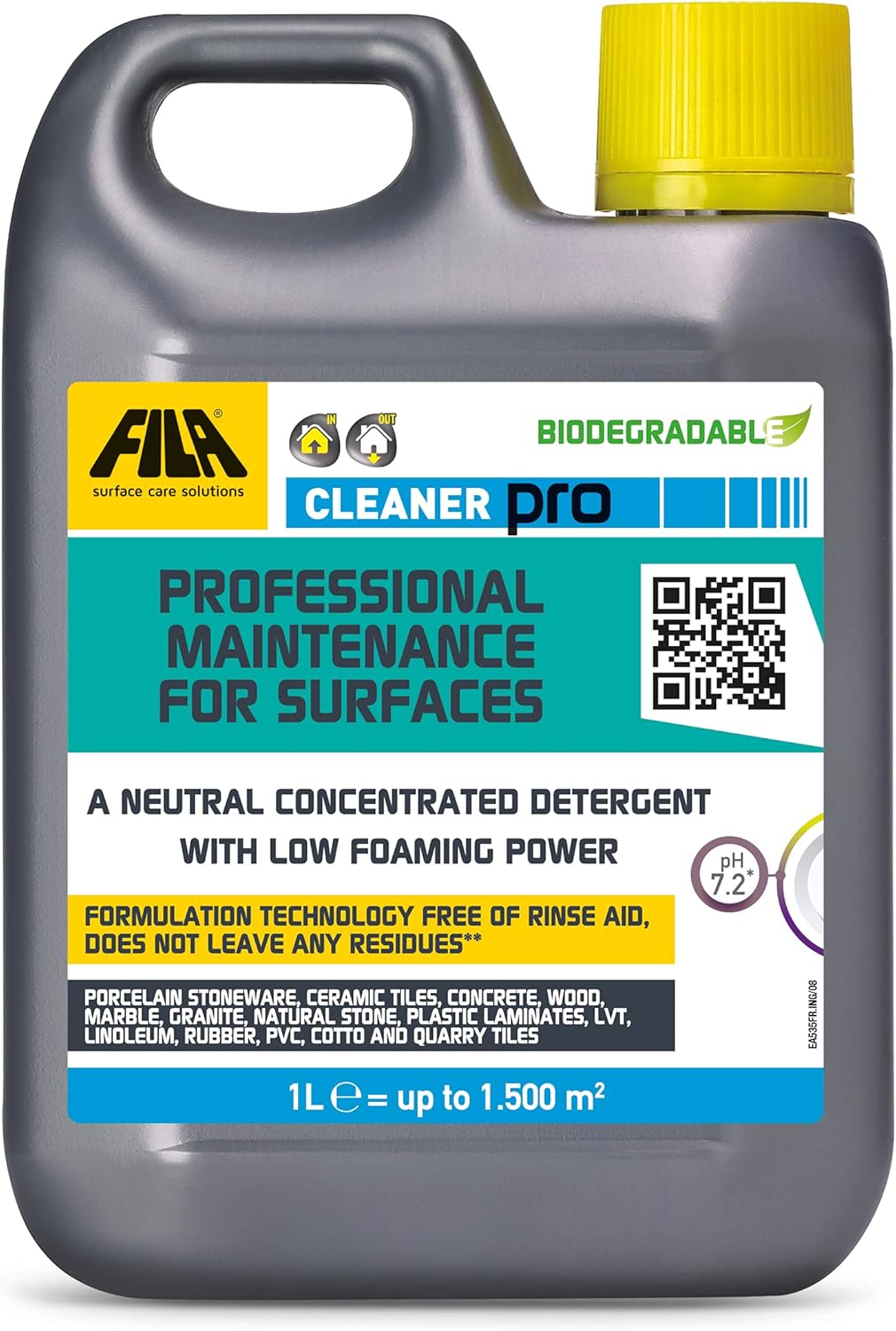
Fila Pro Floor Cleaner
|
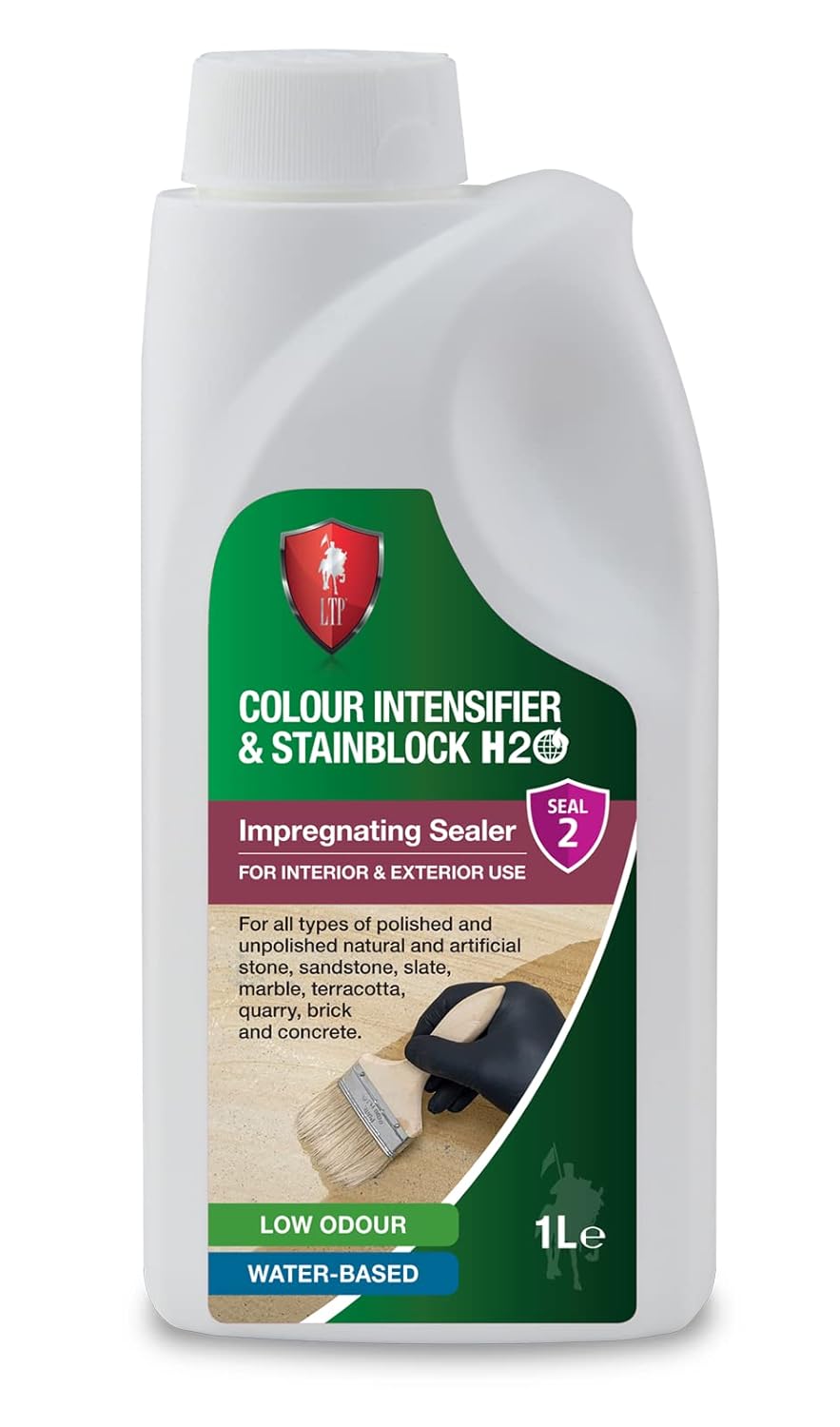
LTP Colour Intensifier & Stainblock H20
|
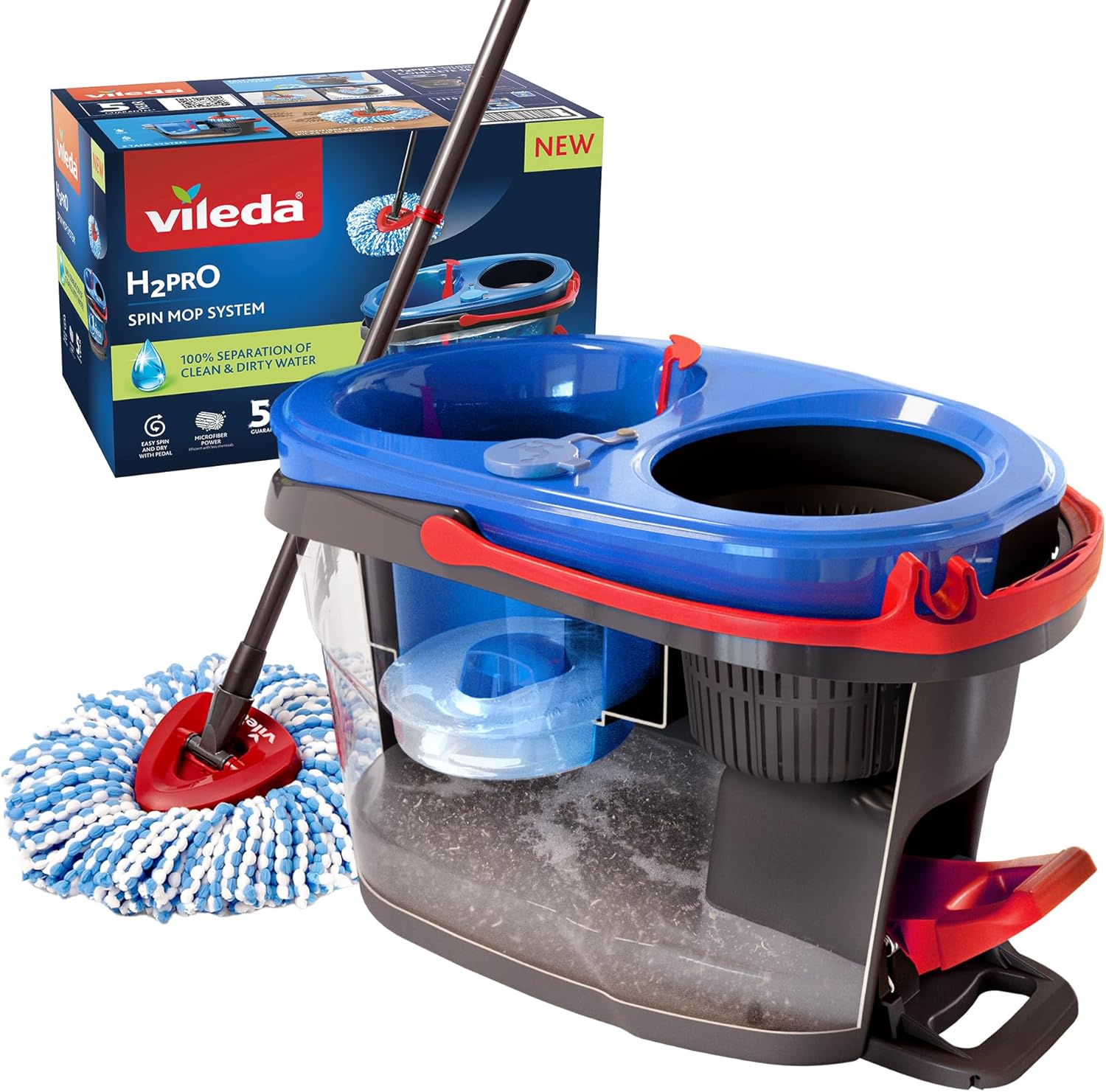
Vileda H2PrO Spin Mop System
|
Over time, however, these beautiful tiles often lose their visual brilliance due to surface wear, chemical effects, and environmental factors. Restoring their original vibrancy involves a specialised approach that requires extensive knowledge of the materials, historically informed techniques, and high-quality products. A professional restoration ensures the longevity and integrity of these stunning surfaces, allowing their history to shine through while maintaining their functional charm, making them a valuable asset in any space.
Why Do Victorian Mosaic Tiles Fade and What Causes Surface Dulling?
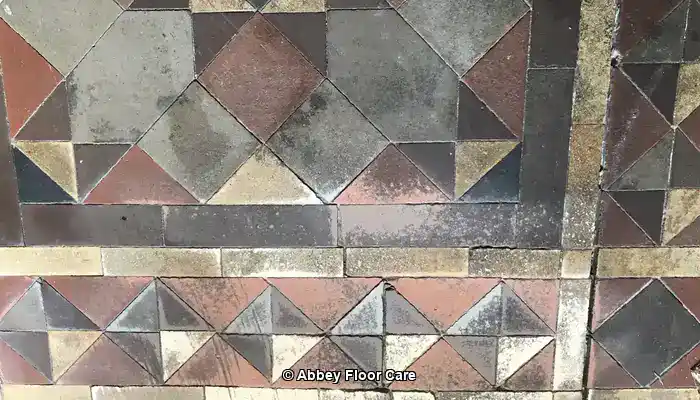
Example of Victorian Clay Tile Floor dulled through surface wear and damage.
Despite the pigments being integral to the tile, numerous factors lead to fading and dulling over time:
- Accumulated dirt and grime: Continuous foot traffic deposits fine particles and oils that penetrate porous surfaces, scattering light and muting vibrant colours, resulting in a significant loss of visual appeal.
- Wax and polish buildup: Layers of wax or sealants that lack breathability trap moisture, resulting in a cloudy or yellowed appearance that obscures the tile’s true beauty, necessitating effective removal for restoration.
- Moisture-driven issues: Many Victorian tiles were installed over subfloors without damp-proof membranes, leading to rising damp that transports soluble salts. These salts crystallise on the tile surface as efflorescence, further masking the original tones and complicating restoration efforts.
- Physical abrasion: Minor surface scratches from years of use disrupt smooth light reflection, diminishing the overall visual richness of the tiles and necessitating careful attention during cleaning and restoration.
Effective restoration processes carefully address each of these contributors without compromising the tile’s historic integrity. By identifying and mitigating the causes of fading, skilled restoration experts can ensure a successful outcome that revitalises these beautiful tiles, restoring their original charm and allure while preserving their significance.
The Crucial Role of Breathability in Restoration When No Damp-Proof Membrane is Present
Because many Victorian tiled floors rest on older subfloors lacking a damp-proof membrane (DPM), their natural clay structure must remain permeable to allow moisture from below to evaporate. Non-breathable wax coatings or film-forming sealers obstruct this evaporation pathway, leading to moisture buildup beneath the surface. This entrapment can lead to salts and humidity issues, causing efflorescence, surface mineral degradation, and the undesirable phenomenon known as wax blooming—a whitish film or haze on the tile. Restoration strategies must prioritise breathable impregnating sealers that protect tiles while allowing moisture vapour to escape freely, thus preventing long-term damage and ensuring the tiles' durability and aesthetic integrity.
Comprehensive Overview of Pigments and Tile Composition in Victorian Floors

An example of different pigments in a Victorian Clay tile floor during restoration by Abbey Floor Care
Diving into Mineral Oxide Pigments Found in Victorian Tiles
Victorian mosaic and encaustic tiles derive their distinctive earthy colours from mineral oxide pigments embedded directly into the clay. These pigments are essential for providing both durability and depth of colour, ensuring the tiles retain their visual appeal over time. The primary pigments include:
- Iron oxide: produces terracotta reds, rust browns, and soft ochres that add warmth and character, enhancing the aesthetic richness of the tiles.
- Manganese: yields deep browns and rich blacks, adding depth and contrast that elevate the overall design.
- Cobalt: imparts a range of blue hues that enhance the aesthetic appeal, contributing to the vibrant palette characteristic of Victorian design.
- Chromium: creates natural green shades that contribute to the vibrant palette, ensuring that the tiles remain visually engaging and historically representative.
The Firing and Fusion Process of Tiles and Its Impact on Durability
During the manufacturing process, the tiles are fired at temperatures around 1100°C, which vitrifies the clay and fuses the pigments deep into the tile body. This critical process ensures that the colour runs throughout the tile rather than merely residing on the surface, providing long-lasting vibrancy and durability. This firing technique is essential in establishing the tile's enduring beauty and resilience, making them well-suited for high-traffic environments where both aesthetics and functionality are paramount.
Understanding the Porous Unglazed Finish of Victorian Tiles
Victorian tiles typically feature a porous, unglazed matte finish, giving them a natural appearance that many find appealing. However, this porosity renders the tiles absorbent and sensitive to surface contamination and moisture, necessitating careful cleaning and maintenance. The unglazed surface also allows for breathability, which is vital for the longevity of the tiles, ensuring that moisture can escape freely and preventing damage over time. This characteristic ultimately enhances their durability and aesthetic appeal, emphasising the importance of proper care.
Variability in Colour Durability of Different Tile Types and Their Maintenance Needs
Natural earth pigments, especially those used in red and yellow tiles, tend to contain fewer mineral additives compared to darker colours such as black, which are formulated with manganese. This difference implies that red and yellow tiles, while visually stunning, are less durable and more susceptible to surface dishing under heavy foot traffic. Such wear manifests as shallow depressions where footfall is concentrated, leading to uneven colour intensity and a loss of surface flatness. Understanding these factors is critical for effective restoration and maintenance, ensuring that the specific needs of each tile type are addressed appropriately.
Key Considerations for Successful Restoration of Victorian Mosaic Tiles
Understanding pigment composition and tile wear patterns is essential when planning restoration efforts. Softer-toned tiles demand gentler cleaning methods and specialized impregnating sealers that respect their physical properties while enhancing their natural colour. Conversely, darker, more resilient tiles can tolerate more intensive cleaning but still require breathable, colour-enhancing protection to maintain their vibrancy over time. This nuanced approach guarantees that each tile is restored with the utmost care and consideration for its unique characteristics, ensuring the best possible outcomes, both aesthetically and functionally.
Advanced Restorative Cleaning Techniques for Victorian Mosaic Tiles
Effective cleaning is crucial to restoring Victorian encaustic and mosaic tiles to their original vibrancy. However, cleaning these tiles necessitates a specialized approach that transcends the use of simple pH-neutral detergents commonly recommended for everyday cleaning. Professional restorers employ carefully formulated alkaline cleaners and mechanical techniques designed to break down heavy soiling and old residues without compromising the historic fabric of the tiles. This meticulous cleaning process is essential for achieving optimal restoration results and preserving the integrity of the tiles while enhancing their visual appeal.
Thorough Debris Removal Techniques for Optimal Cleaning
The cleaning process commences with the removal of all loose dirt and grit using soft brushes or vacuuming with brush attachments. This initial step is vital for preventing scratches on the delicate tile surfaces during subsequent cleaning phases. By diligently removing debris, restorers can ensure that the cleaning process is as effective and gentle as possible, thus preserving the integrity and beauty of the tiles for years to come. This foundational step is critical for achieving successful restoration outcomes.
Utilising Alkaline Cleaners for Intensive Soil Removal and Their Benefits
Unlike pH-neutral cleaners, which often lack the chemical power to tackle ingrained fatty acids and organic soils, alkaline cleaners are invaluable for thoroughly breaking down household oils, grease, and sticky residues commonly found on tile surfaces and within grout lines. These alkaline formulations effectively dissolve the binding agents of dirt, sugars, and fats, facilitating their removal while remaining compatible with the mineral composition of Victorian tiles. This careful balance is crucial to avoid damaging the tiles during the cleaning process, ensuring the restoration process is both effective and respectful of the tiles' original materials.
Professional-grade alkaline products, such as <em>PS87 PRO</em> or custom formulations from heritage cleaning specialists, are typically employed in diluted forms. This ensures comprehensive cleaning without excessive aggression to the clay body. It is essential to remember that, even with alkaline cleaners, exercise caution, and conduct spot testing to avoid potential damage to the tiles, thereby ensuring the best results during the restoration process.
Mechanical Agitation with Appropriate Cleaning Pads for Effective Results
Mechanical action enhances the effectiveness of the cleaning process. Low-speed rotary scrubbers fitted with red or, in some cases, green non-abrasive pads are commonly utilized to agitate soils out of small pits, tile surfaces, and grout lines. These pads clean thoroughly while safeguarding the integrity of tile edges and delicate surface details. This combination of mechanical and chemical cleaning techniques ensures a comprehensive approach to tile restoration, yielding impressive results that restore the tiles to their former glory.
Safely Removing Waxes and Exotic Sealants: Techniques and Considerations
Years of use often result in the accumulation of old waxes and sealants, particularly from DIY attempts utilizing inappropriate products. Water-based cleaners—whether alkaline or mildly acidic—are preferred for removing these residues without damaging the tile’s mineral structure. However, stubborn ‘exotic’ or solvent-resistant coatings necessitate targeted solvent-based removers such as Lithofin Wax-Off or LTP Solvex. These solvents effectively soften and emulsify waxes and old sealants but must be handled with care by professionals trained in their safe application and disposal. Properly removing these compounds is critical for achieving a clean slate for further restoration work and ensuring successful outcomes that respect the tiles' heritage.
The Critical Importance of Rinsing and Drying Techniques in Restoration
Following chemical cleaning, thorough rinsing is essential to eliminate all cleaning residues. Multiple rinses with clean water, coupled with wet vacuum extraction, guarantee that no detergent or solvent traces remain that could interfere with subsequent restoration coatings. This meticulous attention to detail ensures that the tiles are left in pristine condition for the next steps in the restoration process, thereby enhancing the overall quality of the restoration and ensuring that the tiles can be effectively protected and revitalised.
Drying time varies based on environmental conditions, including humidity, surface type, and moisture content. Restoration experts consistently utilize moisture meters to confirm that the tiles are completely dry before applying any impregnating sealers or protective treatments. This precaution prevents moisture entrapment, which could otherwise lead to efflorescence, staining, or damage beneath sealed layers. Ensuring that the tiles are thoroughly dry is a fundamental aspect of successful restoration, enhancing the longevity and performance of the tiles while preserving their historical significance.
The Benefits of Comprehensive Cleaning in Restoration: Uncovering True Tile Conditions
Comprehensive cleaning reveals the actual condition of the tiles by removing visual obstructions. This process uncovers areas that may require repair and provides a clean, receptive surface for colour-enhancing impregnators or other restorative products. This careful preparation is fundamental to the success and longevity of Victorian mosaic tile restoration, ensuring that the tiles can regain their former glory and aesthetic appeal, contributing to the overall beauty of the space while respecting their historical context.
Enhancing Colour with Premium Impregnating Sealers: Key Advantages
Restorers utilize impregnating colour-enhancing sealers produced by LTP and Lithofin, brands recognised for their advanced, heritage-approved formulations. Unlike superficial coatings, these sealers:
- Deeply penetrate tile pores to physically enrich colour by altering light refraction, enhancing visual appeal and bringing out the inherent beauty of the tiles.
- Maintain vapour permeability, which is crucial for moisture escape and is particularly important in older floors lacking DPM layers, preventing potential damage.
- Offer lasting protection against stains and foot traffic without altering the natural texture or gloss of the tiles, ensuring that their authentic appearance is preserved.
- Are applied in multiple light coats, each permitted to penetrate thoroughly before the next is applied to ensure complete uniformity and effectiveness, resulting in a flawless finish.
These sealers directly combat fading by restoring vibrancy while preserving the historic floor’s breathable nature. This combination of features makes them integral to any restoration project, ensuring the tiles retain their beauty and functionality while being well-protected against future damage.
Addressing Physical Repairs for Damaged Tiles and Colour Tinting Techniques
Tiles with chips, cracks, or missing pieces demand careful repair using tinted epoxy or lime-based mortars, colour-matched with natural mineral oxides for a seamless finish. Restoration experts often source matching replacement tiles from salvage archives to maintain pattern continuity and historical accuracy. Colour tinting involves selectively applying earth-pigment-infused wax or resin mixtures to blend worn or missing pattern areas sensitively while respecting the breathability and reversibility of the tiles. This delicate process requires both skill and artistry to ensure that repairs are unobtrusive and preserve the overall aesthetic of the tiles, thereby enhancing their historical significance.
Best Practices for Successful Tinting: Ensuring Quality and Consistency
- Use small, controlled applications to avoid overt colouring that could detract from the tile’s original appearance, maintaining the integrity of the design.
- Conduct patch testing on inconspicuous areas before complete application to ensure compatibility and effectiveness, safeguarding the tiles during restoration.
- Ensure compatibility with the impregnating sealers applied to the entire surface to maintain the integrity of the restoration, ensuring lasting results.
Essential Ongoing Maintenance for Restored Victorian Mosaic Floors
Preserving the restored colour and condition of Victorian mosaic tiles necessitates ongoing care:
- Routine cleaning with pH-neutral, non-abrasive detergents specifically designed for historic tiles is essential for maintaining their appearance and preventing damage.
- Preventive measures, such as placing entrance mats, help minimise dirt ingress and protect the tiles from wear, prolonging their beauty.
- Promptly addressing liquid spills, particularly acidic substances like vinegar or wine, is crucial to prevent surface etching that could mar the tiles' finish.
- Regularly reapplying breathable impregnating sealers every 3–5 years, or as wear dictates, is vital for ongoing protection against stains and moisture ingress.
- Monitoring floors for signs of efflorescence or moisture ingress is crucial, as these issues may indicate underlying damp problems that need to be addressed promptly to prevent further damage.
Steering Clear of Common Restoration Pitfalls in Victorian Tile Care
- Avoid wax treatments that can obstruct breathability, cause efflorescence, or lead to wax blooming on the surface, compromising the tiles' integrity.
- Do not use acrylic or polyurethane sealants that trap moisture and may result in degradation of the tiles over time, jeopardising their longevity.
- Limit the use of harsh chemical cleaners, as they can erode the clay and pigments, undermining the restoration efforts and harming the tiles.
- Never repaint tiles; paint films alter their visual and physical properties and are not reversible, compromising the integrity of the restoration and historical value.
- Recognise and address any issues present in older subfloors before sealing to prevent future complications that could arise from untreated problems.
Highlighting Real-World Restoration Projects: Success Stories
Examples serve to illustrate the successful application of these principles:
Victorian Hallway Restoration Case Study in Sheffield: A Transformative Approach

Our cleaning process effectively removed years of wax and grime, followed by the application of a Lantania Avo colour-enhancing impregnating sealer, which visibly deepened the tile colours. This was then complemented with an acrylic topical sealer to provide surface protection on floors installed over a damp-proof membrane. This careful approach allowed us to enhance the tiles’ original beauty while ensuring their longevity and resilience in a high-traffic area, showcasing the effectiveness of our restoration techniques.
Civic Mosaic Floor Restoration Case Study in Chesterfield: Preserving Historical Integrity

After cleaning and removing old topical sealers, the floor was sealed with an LTP Colour Enhancing Impregnating sealer. The surface was further protected with a wax, carefully applied to integrate the clay tiles seamlessly into the historic fabric of the building. This meticulous process ensured that the restored tiles maintained their historical integrity while offering enhanced protection and aesthetic appeal, showcasing the effectiveness of our restoration techniques and commitment to quality.
Preserving Heritage Through Expert Restoration Techniques: A Commitment to Quality
Restoring the colour and pigment of Victorian mosaic tiles is a multifaceted challenge that balances material science, artistry, and sensitivity to heritage values. Utilizing premium impregnating colour-enhancing sealers from industry leaders like Dry Treat, Lantania, and Lithofin guarantees long-term breathability, protection, and colour vibrancy. Skilled cleaning, careful repair, and dedicated maintenance uphold authenticity while rejuvenating these historic floors for future generations to appreciate. This commitment to excellence in restoration reflects a deep respect for the past while ensuring these captivating tiles can be enjoyed in the years to come, preserving their legacy for future enjoyment.
Frequently Asked Questions About Victorian Mosaic Tile Restoration
What are Victorian mosaic tiles and Their Historical Significance?
Victorian mosaic tiles are decorative tiles that gained popularity in the 19th century, distinguished by their vibrant colours and intricate patterns. They were frequently employed in public buildings and private homes, standing as a testament to the artistry and craftsmanship of the Victorian era, reflecting the social and cultural values of the time.
How can I restore faded Victorian mosaic tiles effectively?
Restoring faded Victorian mosaic tiles involves a comprehensive process that includes cleaning, repairing damages, applying new pigments to match the original colours, and finally sealing the tiles to protect them. This thorough approach ensures that the tiles regain their original beauty and functionality, enhancing the overall aesthetic of the space while respecting their historical integrity.
What materials are needed for effective tile restoration?
Essential materials required for tile restoration include specialized cleaning solutions, pigments, adhesives, grout, and protective sealants, all selected for their compatibility with the original tiles. Choosing the right materials is crucial for achieving a successful restoration that maintains the tiles' integrity and historical value.
How long does the tile restoration process typically take?
The time required for tile restoration varies based on the size and condition of the area being restored, typically ranging from a few days for smaller projects to several weeks for more extensive restorations. Each project is unique and necessitates careful planning and execution to ensure optimal results and respect for the tiles' history.
Can I do the restoration myself, or should I hire a professional?
Yes, smaller restoration projects can be tackled as DIY tasks if you possess the necessary skills and tools. However, more complex repairs demand professional expertise to guarantee quality results. It is vital to evaluate your capabilities before undertaking any significant restoration work to ensure that the tiles are treated appropriately.
What is the cost of restoring Victorian mosaic tiles, and what factors influence it?
Costs for restoration can vary significantly based on the project's size and condition, ranging from a few hundred to several thousand pounds for comprehensive restorations. It is advisable to obtain quotes from professionals to gain an understanding of the potential investment required for your specific project, allowing for effective budgeting and planning.
How do I choose the right restoration expert for my project?
Seek restoration professionals with experience in historical projects, excellent reviews, and a commitment to utilising authentic materials and techniques. This approach will help ensure that your restoration is handled with the care and expertise it deserves, maintaining the integrity of your Victorian tiles while reviving their beauty.
What challenges do restorers face during the restoration process?
Restorers frequently encounter challenges such as matching original colours, repairing damaged tiles, and ensuring the longevity of the restoration work. Each project presents unique obstacles that require thoughtful solutions and a deep understanding of materials and techniques to achieve successful outcomes.
How can I maintain restored tiles to ensure their longevity?
Regular cleaning with pH-neutral products, avoiding harsh chemicals, resealing periodically, and promptly addressing any damage are essential to maintaining restored tiles. Establishing a routine care plan is vital for preserving the beauty and functionality of your restored tiles over time, ensuring that they remain a stunning feature in your home.
What innovations are present in tile restoration today, and how do they benefit the process?
Recent innovations in tile restoration include advanced cleaning solutions, new types of sealants, and digital technology for precise colour matching and pattern replication in restoration projects. Staying informed about these advancements can enhance restoration practices and improve outcomes, ensuring the best possible care for your Victorian tiles while respecting their heritage.
The Article Restoring Colour and Pigment to Faded Victorian Mosaic Tiles first found on https://www.abbeyfloorcare.co.uk
The Article Restoring Victorian Mosaic Tiles: Reviving Colour and Pigment appeared first on https://fabritec.org
The Article Restoring Victorian Mosaic Tiles for Vibrant Color Revival Was Found On https://limitsofstrategy.com





No responses yet